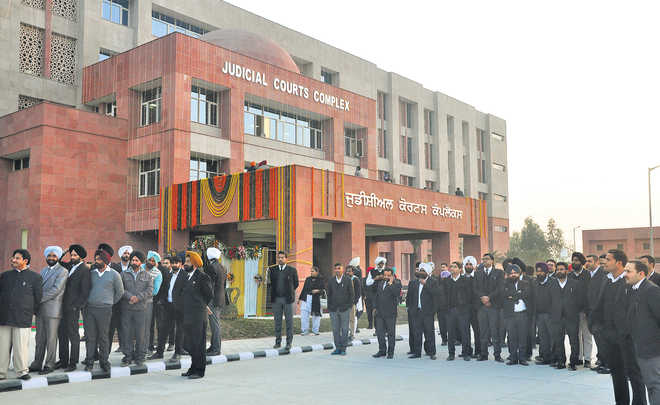
Sumathi Chandrashekaran
Senior Resident Fellow, Vidhi Centre for Legal Policy
A host of new judges was appointed to the Indian higher judiciary last week. But the high courts and the Supreme Court continue to work with a large number of vacancies. It gets worse as one goes lower down the order, to district and subordinate courts. According to data available from the judiciary, over the half-dozen quarters preceding March 2017, the lower judiciary has been functioning at an average of 75-80 per cent capacity of its sanctioned strength.
India has, for too long, had conversations about the insufficient number of judges in the system. But the discussion has tended to focus on judges in the higher courts, where the appointments process has been the arena for public disagreements between the judiciary and the executive. The more mundane appointments happen in the lower courts, which is also where most people tend to head to as their first course of redress. A little more attention paid to these appointments processes could go a long way in preventing the lower courts from implosion and collapse due to overwork and pendency.
Recruitments to lower court judicial positions in India are managed by various high courts for courts in their states and state public service commissions (PSCs).
Concerns with recruitment
A study of their appointment processes reveals a few concerns with recruitment.
Erratic recruitment cycles: The main concern is that recruitment cycles have been erratic and unpredictable. Based on information available, it appears that there have sometimes been years on end without examinations being conducted for certain states.
Long recruitment cycle: Even if examinations take place, the recruitment cycle in its entirety takes an unpredictable amount of time. This could be for various reasons. Some exams have run into legal challenges because of alleged indiscretions in the manner in which they were conducted.
Interviews not held: Yet other cycles have slowed down because interviews have not taken place, or results of exams have not been released (many exams still require long-form answers, which correspondingly take that much longer to evaluate).
Some vacancies remain unfilled: Even if cycles eventually get completed, sometimes, the number of seats originally advertised as being vacant and available do not get filled. This could either be due to the poor quality of candidates who appeared for tests, or perhaps even because courts may be unable to accommodate the number of judges originally advertised for.
Ironing out concerns
With more systematic resource planning, all of these concerns can be easily ironed out. The critical pieces of information required to plan for future recruitment are already available.
- First, courts have knowledge of how many judges are currently working in the system.
- Second, they are aware of their sanctioned strength, and how many vacancies exist.
- Third, they know how many vacancies are likely to arise in the course of the following years as a result of the promotion or retirement of sitting judges.
- Fourth, they have information about normal attrition rates from historical data, based on how many judges leave judgeship to practice or for other purposes.
- Fifth, they know the number of applications they receive in response to a call for recruitment, and the percentage of those they eventually select (ie, the ratio of applicants to successful candidates).
- Sixth, they have information about the number of judges they can reasonably accommodate given limitations of infrastructure, for example, how many physical courtrooms are available for occupancy.
- Finally, it is also clear as to how long it takes a particular court or PSC to conduct a recruitment cycle.
With all this information, it is a fairly straightforward exercise to calculate how often a state needs to conduct recruitments, the number of vacancies it needs to recruit for, and at what level of judgeship these positions exist.
In India, the Union Public Service Commission (UPSC) puts out an annual recruitment calendar, where it lists out the datesheet for forthcoming examinations every calendar year, offering potential applicants basic information to prepare for selection.
If courts attempt a greater degree of resource planning than they do at present, the net benefits that accrue will extend well beyond the judicial system itself. Better information for candidates would mean better preparedness for examinations, and correspondingly higher quality participation. Courts are also likely to be more regularly staffed, and not have to deal with vacancies and burgeoning caseloads. Additionally, litigants will know their cases are likely to be heard in reasonable time, rather than having to face the prospect of empty courtrooms.
It is a truism that if you do not have enough people in an organisation, there is a good chance that the existing people will suffer from burnout. To prevent this, the talent pool needs to be continuously refreshed, so that there is a healthy input of fresh ideas and energy. When it comes to the arms of the government like the judiciary, keeping the cycle going is imperative.
The UK’s ‘selection exercise’
The United Kingdom uses information to design its "forward programme for judicial recruitment". In this, the recruitment cycles, which are called "selection exercises", for all tiers of the judiciary, including tribunals, are mapped out for the next five years. The latest such programme was put out in late 2017. If you are a prospective candidate for judgeship, this programme helps you plan out your applications process over the course of the next half a decade, select the roles you want to apply for, seek out mentors, and so on. This planning does not take away from specific ad hoc recruitments, on a needs-basis.



























